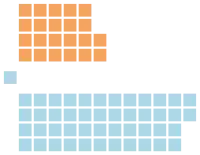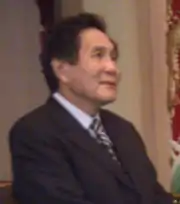1986 British Columbia general election
The 1986 British Columbia general election was the 34th general election in the Province of British Columbia, Canada. It was held to elect members of the Legislative Assembly of British Columbia. The sitting Social Credit government was re-elected.
| |||||||||||||||||||||||||||||||||||||||||||||
69 seats of the Legislative Assembly of British Columbia 35 seats were needed for a majority | |||||||||||||||||||||||||||||||||||||||||||||
|---|---|---|---|---|---|---|---|---|---|---|---|---|---|---|---|---|---|---|---|---|---|---|---|---|---|---|---|---|---|---|---|---|---|---|---|---|---|---|---|---|---|---|---|---|---|
| Turnout | 65.8%[1] | ||||||||||||||||||||||||||||||||||||||||||||
| |||||||||||||||||||||||||||||||||||||||||||||
 | |||||||||||||||||||||||||||||||||||||||||||||
| |||||||||||||||||||||||||||||||||||||||||||||
The election was called on September 24, 1986. The election was held on October 22, 1986, and the new legislature met for the first time on March 9, 1987.
The governing British Columbia Social Credit Party (Socreds) had seen a leadership change just months before the election, with Bill Bennett standing down in favour of Bill Vander Zalm. Promising a fresh start after the Bennett years, Vander Zalm led the Socreds to a fourth consecutive majority government, although with winning less than half of the popular vote. 12 new seats had been created in the legislature for this election. Social Credit coincidentally won 12 additional seats, while the social democratic New Democratic Party, led by Bob Skelly, won the same number it had in the previous election. No other parties won seats. In fact the two leading parties together - SC and NDP - took more than 90 percent of the votes.
There were 17 two-member constituencies in this election. Voters in these places were allowed two votes (Block Voting), and generally used them both on the same party, with the largest group (even if not a majority) taking both seats.
Only one district elected both a SC and a NDP MLA. This was Vancouver-Point Grey where two women, an NDP member and a Socred (Kim Campbell, later a Canadian prime minister), were elected.
All other districts elected either two Socreds (12 districts) or two NDP members (four districts), with no representation given to the minority vote in the district. That helped ensure the government's capture of the most seats.[lower-alpha 1]
It was the last election to be held with multi-member districts since BC moved to all single-member districts prior to the next election.
Opinion polls
| Polling firm | Last day of survey |
Source | BCSC | BCNDP | BCLP | PCBC | Other | ME | Sample |
|---|---|---|---|---|---|---|---|---|---|
| Election 1986 | October 22, 1986 | 49.32 | 42.60 | 6.74 | 0.73 | 0.61 | |||
| United Communications Research | October 1986 | [2] | 48 | 30 | 6 | 4 | — | 3.64 | 725 |
| United Communications Research | September 1986 | [2] | 50 | 29 | 6 | 3 | — | — | — |
| Election 1983 | May 5, 1983 | 49.76 | 44.94 | 2.69 | 1.16 | 1.45 |
Results
| Party | Party leader | Candidates | Seats | Valid votes received | ||||||
|---|---|---|---|---|---|---|---|---|---|---|
| 1983 | Dissol. | 1986 | Change | # | % | % Change | ||||
| Social Credit | Bill Vander Zalm | 69 | 35 | - | 47 | 954,516 | 49.32% | -0.44% | ||
| New Democratic | Bob Skelly | 69 | 22 | - | 22 | 824,544 | 42.60% | -2.34% | ||
| Liberal | Art Lee | 55 | - | - | - | - | 130,505 | 6.74% | +4.05% | |
| Progressive Conservative | Vacant[lower-alpha 2] | 12 | - | - | - | - | 14,074 | 0.73% | -0.43% | |
| Green | 9 | - | - | - | - | 4,660 | 0.24% | 0.05% | ||
| Independent | 6 | - | - | - | - | 2,470 | 0.13% | -0.19% | ||
| Libertas | 1 | - | - | - | - | 1,552 | 0.08% | - | ||
| People's Front | 8 | - | - | - | - | 1,502 | 0.08% | - | ||
| Communist | 3 | - | - | - | - | 722 | 0.03% | -0.02% | ||
| Libertarian | 3 | - | - | - | - | 341 | 0.02% | - | ||
| Western Canada Concept | Doug Christie | 1 | - | - | - | - | 322 | 0.02% | -0.84% | |
| New Republic | 1 | - | - | - | - | 245 | 0.01% | - | ||
| Total | 237 | 57 | 57 | 69 | 1,935,453 | 100 | - | |||
| Total voters voting | ' | ' | ' | ' | ' | 1,366,193 | ' | - | ||
| Source: Elections BC | ||||||||||
Notes and References
Notes
- Block voting also perhaps makes the popular vote – the number of votes cast – not truly reflective of the sentiment of the voters since some voters cast two votes, and others cast only one.
- Party leader Peter Pollen quit shortly before the election was called.
References
- "B.C. Voter Participation: 1983 to 2013" (PDF). Elections BC. Archived from the original (PDF) on March 28, 2019. Retrieved May 11, 2017.
- "NDP edges closer to Socreds in polls". The Ottawa Citizen. October 11, 1986. p. A13.
Further reading
- Byers, R. B., ed. (1990). Canadian Annual Review of Politics and Public Affairs, 1986. Toronto: University of Toronto Press. ISBN 9781442671997.
